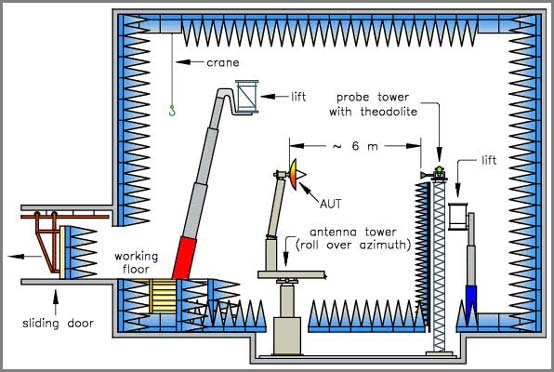The DTU radio anechoic chamber
Since its opening in 1967, the Radio Anechoic Chamber at the Technical University of Denmark (DTU) has been used extensively both for in-house research projects and teaching purposes, and for measurement programmes conducted in collaboration with and on behalf of external customers. The anechoic chamber is intended for the determination of antenna characteristics in the frequency range from 500 MHz to 40 GHz. It is 12 m long, 10 m wide and 8 m high (measured between the tips of absorbers). The chamber and control room are enclosed in RF shielding.

Near-field methods
Near-field methods of antenna testing come into their own for microwave antennas, for which the far-field distances exceed the dimensions of the test range. The maximum measurement distance in an anechoic chamber is about 10 m, and the prediction of antenna far-field radiation patterns from near-field measurements is therefore an area of considerable interest. Several studies have been carried out over the years with planar, cylindrical and spherical near-field probing. In this domain, the development of the basic theory of probe-corrected spherical near-field measurements by F. Jensen (1970) deserved special mention.
Spherical near-field antenna testing
The spherical measurement surface is the most general for near-field measurements, implying that the far field can be determined in all directions. All kinds of antennas can then be measured: pencil-beam, contoured-beam, wide-beam antennas and also feed systems. Spherical near-field testing was selected by ESA at an early stage as a highly promising technique for accurate calibration of spacecraft antennas. Since 1977 ESA and DTU (with TICRA as subcontractor) have collaborated in a joint venture to develop and implement a spherical near-field test facility in the DTU radio anechoic chamber. The facility was operational for the first time in April 1979 and since then several complete studies and a large number of spherical near-field measurement have been carried out on different antenna types. The results obtained so far have fully confirmed the high accuracies expected of this method.